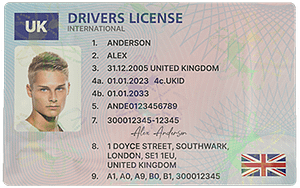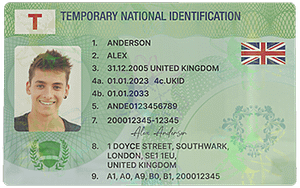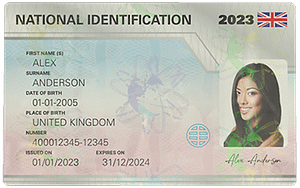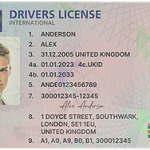Holograms have become an important feature in the world of identification cards, both for real and fake ones, but with very different implications. In the realm of legitimate identification, holograms play a crucial role in enhancing security and authenticity.
The Role of Holograms in Real ID Cards
Real – ID cards, such as driver’s licenses, passports, and national identity cards, incorporate holograms as a sophisticated security measure. These holograms are created using advanced optical technologies. They are often multi – layer and multi – dimensional, making them extremely difficult to replicate accurately.
One of the key aspects of holograms on real ID cards is their ability to display unique patterns and images that change when viewed from different angles. For example, a hologram on a passport might show a national emblem or a specific symbol that seems to move and transform as the card is tilted. This dynamic visual effect is not only aesthetically pleasing but also serves as a quick and easy way for authorities to verify the authenticity of the card at a glance.

Moreover, holograms on real ID cards can contain micro – text or other hidden features that are only visible under magnification. These hidden elements add an extra layer of security, as counterfeiters would need advanced equipment and techniques to reproduce them accurately. In addition, the materials used in creating these holograms are often of high quality and have specific optical properties that are difficult to imitate. For instance, some holograms are made using special films with precise refractive indices, which contribute to their unique visual appearance.
The Use of Holograms in Fake ID Cards
Fake ID card manufacturers often attempt to incorporate holograms to make their counterfeit products appear more authentic. However, the quality of holograms on fake ID cards is usually far inferior to those on real ones. Counterfeiters may use lower – quality materials and less advanced manufacturing techniques.
Some fake ID holograms may lack the same level of detail and complexity as real ones. They might not display the proper dynamic effects when viewed from different angles or may have visible flaws in the pattern. For example, a fake driver’s license hologram might look flat or have distorted images compared to the high – quality, three – dimensional appearance of a real one. Additionally, the micro – text and hidden features that are characteristic of real ID holograms are often poorly reproduced or completely absent in fake ones.

Another common issue with holograms on fake ID cards is that they may not adhere properly to the card surface. The adhesive used in counterfeiting may be of substandard quality, causing the hologram to peel off easily or look uneven. In contrast, real ID card holograms are carefully applied using high – quality adhesives that ensure a long – lasting and seamless integration with the card.
Detecting Hologram Differences between Real and Fake ID Cards
For law enforcement and other verification authorities, being able to distinguish between the holograms on real and fake ID cards is of utmost importance. One of the simplest methods is visual inspection. By looking at the hologram from different angles, they can check for the proper dynamic effects. A real ID hologram should display smooth and consistent changes in the pattern and image, while a fake one may have jerky or inconsistent movements.
Using magnification tools can also be helpful. As mentioned earlier, real ID holograms often have micro – text and other hidden features that can be detected under magnification. If these features are missing or poorly reproduced in a suspected fake ID, it is a strong indication of its counterfeit nature. In addition, comparing the hologram on a suspect ID card with a known genuine one of the same type can reveal differences in color, clarity, and overall appearance.

Advanced techniques such as using specialized optical equipment can also be employed. These devices can analyze the optical properties of the hologram, such as its refractive index and diffraction patterns, to determine its authenticity. For example, a real ID hologram will have specific optical signatures that are unique to its manufacturing process, and if a suspect hologram does not match these signatures, it is likely to be fake.
Common Problems and Solutions
Problem 1: Inability to Detect Subtle Hologram Flaws
Sometimes, verification personnel may miss subtle flaws in a fake ID hologram during a quick visual inspection. This can be due to inexperience or the fact that the counterfeiter has made a relatively good attempt at replication.
Solution: Provide comprehensive training to verification staff on the details of real ID holograms. This training should include hands – on experience with both real and sample fake ID cards, highlighting the common and subtle differences in hologram features. Regularly update the training materials to keep up with the latest counterfeiting techniques and the evolution of real ID hologram security features.
Problem 2: Lack of Access to Magnification Tools
In some situations, verification authorities may not have access to proper magnification tools, such as magnifying glasses or microscopes, which are essential for detecting micro – text and other hidden features in holograms.
Solution: Ensure that all verification points, such as border control checkpoints, security desks, and licensing offices, are equipped with the necessary magnification tools. Implement a maintenance and replacement schedule for these tools to ensure they are always in good working condition. Additionally, provide training on how to use these tools effectively for hologram inspection.
Problem 3: Difficulty in Comparing Holograms
When comparing a suspect ID card hologram with a genuine one, it can be challenging to identify differences accurately, especially if the genuine card is not of the exact same issue or version as the suspect card.
Solution: Create a comprehensive database of hologram images and features of different real ID card versions. This database can be accessed by verification personnel, allowing them to compare the hologram of a suspect card with the appropriate reference image. The database should be regularly updated to include new ID card designs and security features.
Problem 4: Advanced Counterfeiting Techniques
Counterfeiters are constantly evolving their techniques to create more realistic – looking holograms on fake ID cards, making it harder to detect fakes.
Solution: Invest in research and development to stay ahead of counterfeiting trends. This can involve collaborating with hologram manufacturers and security experts to develop new and improved hologram security features for real ID cards. Additionally, share information about new counterfeiting techniques among law enforcement agencies and verification authorities to enhance their detection capabilities.
Problem 5: False Positives in Hologram Detection
Sometimes, due to natural wear and tear on a real ID card or variations in manufacturing, a genuine ID may be incorrectly flagged as fake based on hologram inspection.
Solution: Develop a secondary verification process for cases where a false positive is suspected. This can include cross – referencing the ID card details with official databases, such as identity records or driver’s license databases. Additionally, establish a quality control system for real ID card manufacturing to minimize variations that could lead to false positives.


